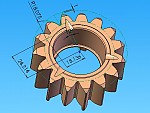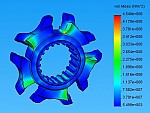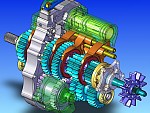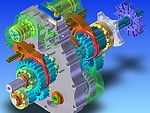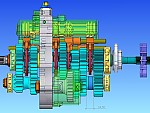This year of the breathtaking and dramatic, fascinating as well as cruel show titled Lisbon - Dakar Rally is behind us. The tension that accumulated in the members of race teams who could not stand straight in the heat of events, thus being forced to observe the course of the action remotely on their PC’s, is slowly fading away, and there comes our opportunity to recall the atmosphere of African pistons and sand dunes - this time using the technologies applied under construction of Competition Specials – and to give a thought to development trends in the field of tractions and drive applications.
One day during summer 2005 we were spoken to by Ing. Miroslav Zapletal asking us to elaborate project for the gearbox of Mitsubishi Pajero Di-D that was de facto a logical continuation of our relatively successful development of hydraulically controlled inter-axle final drive for Suzuki Jimny. That time we had absolutely no suspicion yet what a difficult journey our Pajero gearbox would set out on in January 6, 2007… But let’s keep sequence of the events:
There was a gearbox in the beginning that was developed under the rules for cross country rally so that, in practice, two possible design variants were at hand: either the five-speed gearbox with supplementary reduction or the six-speed gearbox without reduction. The choice was made absolutely unambiguously for the six-speed gearbox variant that makes use of the spectrum of engine’s performance characteristics much better. Given the very favourable liberalness of regulations it was possible to optimize the transference numbers of individual speeds and hence “tailor-make the gears (for Taylor:)”. This is the most important factor that it is for sure worthwhile to explain it in more detail using simple theories of the elementary Newton’s physics.
Any racing car (whether it is WRC car, truck or formula one) is driven to its destination point with certain force. We can simply imagine this force, for example, by figuring that we are drawing the car on a rope (or pushing it). Let’s designate this force as a measure of certain drive output in a sense of the quickest possible reaching of the destination point; then it is apparent that the greater the force that “hauls” (pushes) the car the sooner (quicker) we will reach the destination point. The force F we are talking about here is a result of the action of torque Tk transmitted to the driven wheels and this force can be established very easily as a ratio of the torque on wheels and the wheel rolling radius r, that is
F = Tk / r [N; Nm, m]
This force acts in the wheel hub’s axis and it is apparent from the relationship above that if we require a maximum force (i.e. maximum drive output) we have to provide a maximum torque on the driven wheels.
Another important factor for a project of transference numbers is a linkage between engine and torque Tk of the driven wheels of the car.
Any rotary machine, thus an internal combustion engine as well, is in principle characterized by two variables: engine torque Tm [Nm] and engine’s output P [kW], depending on the speed. The relationship between the torque on wheels and the engine torque is very simple:
Tk = Tm . i
So the locus classicus would be- the “twist” on wheels equals to the engine “twist” multiplied by a spread between the engine and wheels. To give a notion, we have got a sum torque of 8700 Nm on the wheels for the engine torque of 500 Nm and the torque of the first gear change of Zapletal’s Pajero i=17,425 which gives a force of almost 22 kN for a wheel radius of 400 mm (to give a notion, this corresponds to a weight of a little more than two tons).
Let’s unify our simple formulas now:
F = Tk / r = (Tm . i) / r
We arrive at a crucial relationship which so to speak changes the motorsport history in its very consequence, unfortunately, for an overwhelming majority of cases, in the wrong direction. That is, the force driving the car to its destination point is directly proportional to the product of engine torque and the spread between the engine’s crankshaft and the wheels.
In the relationship we leave the product’s parentheses on purpose to emphasize significance of the correlation of these two variables, that is, the engine torque and the spread. In this context, it is our duty, however, to caution very strongly against fatally wrong conclusion frequently arrived at from this simple formula that >the higher the (engine) “twist” the better<… This statement is absolutely misleading and totally out-of-the-way. This formula’s hardship consists in the fact that it does not describe the link between the engine torque and possible variants of transference number in dependence on the car velocity.
Let’s take a look at specific values of Zapletal’s Pajero Di-D’s engine in a graph and monitor the amounts of torques on wheels for the marked conditions.
Mitsubishi Pajero Di-D engine’s graph
[STAV „A“/“B“ = CONDITION “A“/“B“]
Say that our Pajero moves to the 3rd speed gear at engine speed of 2000 rpm, that is, in this case, a velocity of 44 km/hr (condition A). At this speed the engine reaches its torque peak of 610 Nm. The gear change to the 3rd gear is 6.83, followed by the torque on wheels of 610 * 6.83 = 4168 Nm, and the force that “pulls” the car to the destination point is 4168/0.400=10420 N (to give a notion, this corresponds to a weight of about 1 ton). Let’s see what happens if we change down to the second gear at the same instantaneous velocity of the car (condition B): the engine speed will go up to 3000 rpm (velocity remains those 44 km/hr), the engine torque is mere 505 Nm for a speed of 3000 rpm, the gear change to the 2nd gear is 9.823, so we can establish the following for the torque on wheels: Tk=505* 9.823=4960 Nm, force F=4960/0.400=12400 N, that is by 19% more than in the first described condition A!
Thus we get to an illusory paradox implying that by operating the engine in the area of lower torque we achieve higher drive output of a car. This is a matter of extreme significance which must be kept in mind all the time when designing transmissions for Competition Specials.
Thus, let’s summarize our findings into several points:
(1) It is essential for a maximum car’s drive output to reach the maximum “traction” (thrust) force.
(2) It is essential for a maximum car’s drive output to reach the maximum torque on the car wheels.
(3) The amount of engine torque is not essential for a maximum car’s drive output.
(4) The amount of product of engine torque and specific transference number is essential for a maximum drive output.
With regard to points (3) and (4) of our conclusions, we can give a straightforward answer to a question of the following type: what is more convenient for a racing car– gasoline engine, or Diesel engine that has much higher torque value in comparison to the gasoline engine? We have to realize that the equally powerful Diesel engine reaches it torque peak at far lower speed than the gasoline engine so that what we gained from the engine torque TDi is what we in no time lost on a spread. Therefore the product (Tm.i) for two cars moving at the same velocity and equipped with the equally powerful engines of various types will be one and the same number and we have gained absolutely no advantage through the high value of engine torque TDi.
For completeness’ sake we supply unambiguous relationship for the establishment of driving power that already respects the linkage between the gears, engine, and driving velocity:
F = P . (i/ n) / r [kN; kW, 1/s, m]
A completely unambiguous and common conclusion can be uttered only on a basis of this relationship – that the maximum driving power can be attained just at the moment when we operate the engine in the area of its output peak (not in the area of torque peak). A mathematical proof for this statement is by no means complex, however, it would make out for separate article.
The design of our gearbox thus started from the above mentioned conclusions when we distributed the transference numbers equally for the car to reach a maximum velocity of 160 km/hr for 3500 rpm so that, in changing a gear, the output minimum is lost and by doing so we attain the maximum possible car acceleration during drive. All of this would not be feasible at all without knowledge of the above described problems, of course.
When “D” day turned up that decision was made whether the Miroslav Zapletal-Miloslav Janáček crew would take its part in the Lisboa-Dakar Rally, the life-long optimization of our gearbox was initiated. We had to be sure that the gearbox would manage a minimum of 5000 km under full load (since a preventive replacement of gearbox is presumed for rally’s halfway). It was not easy at all and we made a series of alterations, for example, in the area of tooth system geometry. All of the gear assemblies are cut with wire so that the involute surfaces were replaced with a set of circular arcs with a precision to ±0.0025 mm and equipped with vertical modification.
The further significant advantage of this technology is the optimizing possibility of meshing ratios in the tooth system without being limited by the fixed values of generating tools.
We submitted the type tested parts to FEM strength analysis that helped us to optimize the weight distributions for a given specific state of stress.

It was rather a teaser to set the 1st speed gear. The gearing used in cross country was not acceptable for the African sand dunes so we were forced to modify several times our early projects, each time on the basis of sand tests in Slovakia. The same applies for the reverse gear that, when in dunes, is virtually of the same importance as the first gear.
What is worth noting is the design of advance devices when we managed to use a clever geometric arrangement of gear-shifting blocks to minimize the width of these blocks. By doing so, the space of housing for active toothed rims is maximised.
In conclusion we indicate technical parameters of the gearbox of Mitsubishi Pajero car:
Type: sequential, manually shifted
Number of speed gears: 6
Gear-shift layout: R-N-1-2-3-4-5-6-R-N-1-…
Type of gearing: spur, direct, height adjustable, high tooth
Shift block system: SIDU
Reverse gear shifting: before neutral, or behind the 6th speed gear
Gearshift performance: 80-125 ms
Input torque: 800 Nm max.
Gearshift indication: display with photodetector
Lubrication: forced, with circulating pump and supplementary radiator
Working temperature: 94 ÷108°C
Authors: Mr. Dušan Šimek, Mr. Alois Jančík








